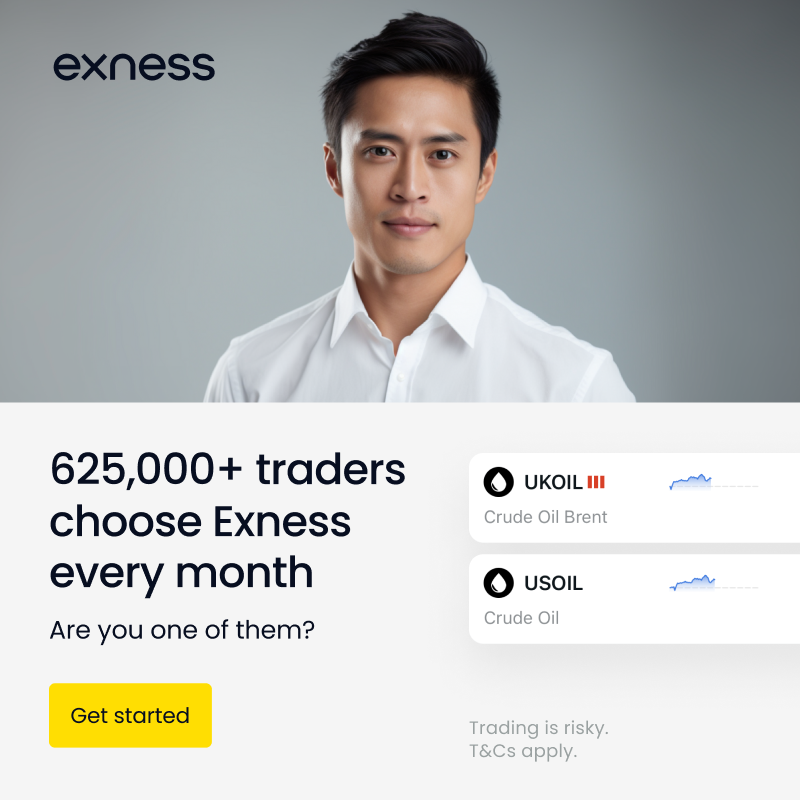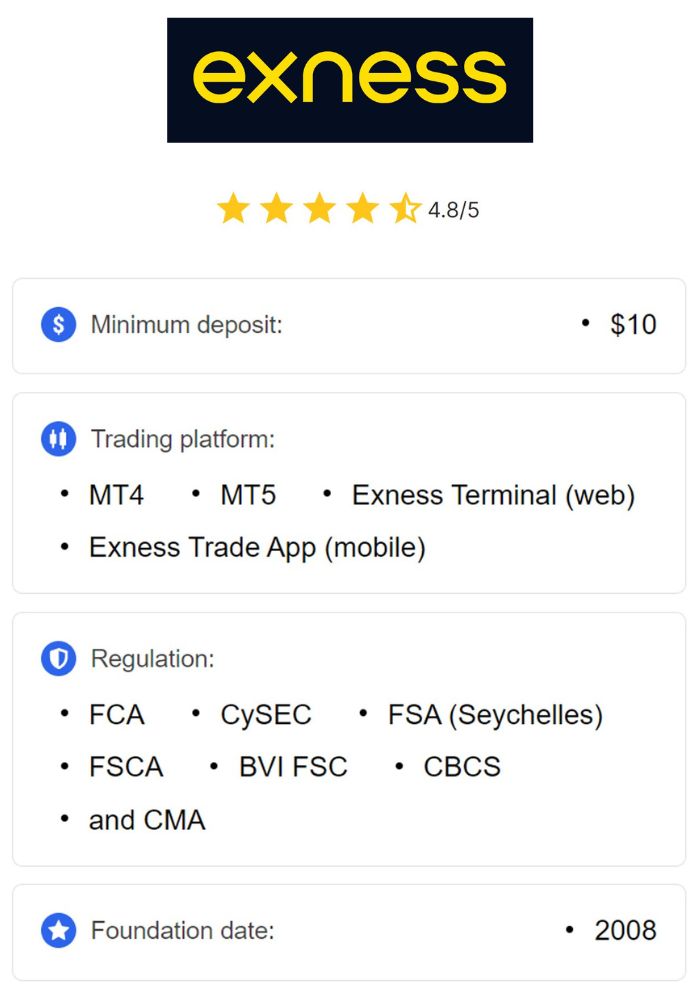
14 minute read
How to Open a Forex Account in India
from Exness
by Exness Blog
Understanding Forex Trading
What is Forex Trading?
Forex trading, also known as foreign exchange trading, is the act of buying and selling currencies in the global market with the goal of making a profit. In forex trading, currencies are traded in pairs, such as USD/INR or EUR/USD, where one currency is exchanged for another. This market operates 24 hours a day, five days a week, across global financial centers, making it the largest and most liquid financial market in the world. Forex trading is popular among investors, corporations, and retail traders who seek to diversify their investment portfolios, hedge against currency risks, or speculate on currency movements.
Top 4 Best Forex Brokers in India
1️⃣ Exness: Open An Account or Visit Brokers 🏆
2️⃣ Avatrade: Open An Account or Visit Brokers 💯
3️⃣ JustMarkets: Open An Account or Visit Brokers ✅
4️⃣ Quotex: Open An Account or Visit Brokers 🌐
Importance of Forex Trading in India
Forex trading has gained popularity in India as an additional income source and an opportunity to participate in the global financial market. With India being a major player in international trade, fluctuations in currency rates can impact both importers and exporters. Forex trading provides a way for businesses to hedge against foreign exchange risks. For retail traders, forex trading offers potential financial growth and a flexible trading environment that can be accessed from anywhere, thanks to online trading platforms.
Legal Framework for Forex Trading in India
Regulatory Authorities in India
In India, the Reserve Bank of India (RBI) and the Securities and Exchange Board of India (SEBI) are the primary regulatory bodies overseeing financial markets, including forex trading. The RBI regulates foreign exchange transactions under the Foreign Exchange Management Act (FEMA), while SEBI monitors securities and trading platforms to ensure transparency and protect investors. These regulatory authorities ensure that all forex trading activities within India are conducted legally and transparently, protecting traders and the economy.
Guidelines for Retail Forex Trading
Retail forex trading is allowed in India but is restricted to currency pairs involving the Indian Rupee (INR). These pairs include USD/INR, EUR/INR, GBP/INR, and JPY/INR. Cross-currency trading (trading currency pairs that do not involve INR) is only available through Indian exchanges like the NSE (National Stock Exchange) and BSE (Bombay Stock Exchange), not through international forex brokers. Indian residents are prohibited from trading in cross-currency pairs with offshore brokers due to restrictions under FEMA.
Choosing the Right Forex Broker
Factors to Consider When Selecting a Broker
Choosing the right broker is critical for a secure and successful trading experience. Here are some key factors to consider:
Regulation and Licensing: Ensure that the broker is regulated by reputable authorities, such as SEBI or an international regulatory body like FCA (UK) or ASIC (Australia).
Fees and Spreads: Look for brokers with competitive spreads and minimal fees to reduce trading costs.
Trading Platform: Choose a broker offering a reliable, user-friendly platform with essential tools for analysis.
Customer Support: Opt for a broker with responsive customer support to help with any queries or issues.
Account Types: Select a broker that offers account types tailored to your trading needs and experience level.

💥 Trade with Exness now: Open An Account or Visit Brokers 🏆
Types of Forex Brokers
Forex brokers can be broadly classified into two types:
Market Makers: These brokers set their own bid and ask prices and often provide fixed spreads. Market makers are suitable for beginner traders who prefer stable spreads and simplified trading.
ECN (Electronic Communication Network) Brokers: ECN brokers provide access to the interbank market, offering variable spreads and charging commissions on trades. ECN brokers are ideal for advanced traders seeking lower trading costs during high liquidity.
Evaluating Broker Credibility and Reviews
Evaluating a broker’s credibility is essential. Traders can read online reviews, check regulatory records, and consult forex forums for firsthand accounts of other traders’ experiences. It’s important to ensure that the broker has a strong reputation, transparent policies, and no history of regulatory breaches or unethical practices.
Preparing to Open a Forex Account
Required Documentation for Account Opening
To open a forex account in India, you must provide certain documents to verify your identity and residence. This documentation is necessary for complying with KYC (Know Your Customer) regulations, ensuring safe and legitimate trading practices. Here’s a breakdown of what you’ll need:
Proof of Identity: A valid passport, Aadhaar card, PAN card, or voter ID. The chosen document must display your photograph and personal details clearly.
Proof of Address: A recent utility bill, bank statement, or Aadhaar card with your address listed. The document should be recent, typically issued within the last three months, to confirm your current residence.
PAN Card: The Permanent Account Number (PAN) card is mandatory in India for tax-related purposes and is required by brokers to facilitate trading.
Bank Account Details: Bank account information, including a canceled cheque or bank statement, is often needed for setting up deposit and withdrawal channels.
Providing these documents in a high-quality, legible format helps expedite the account verification process, allowing you to start trading sooner.
Understanding Different Account Types
Forex brokers usually offer multiple account types to cater to different trader profiles and experience levels. Understanding the options available can help you choose the right one for your needs:
Standard Accounts: Suitable for more experienced traders, standard accounts often offer full access to features, tighter spreads, and higher leverage. They may require a higher minimum deposit than other account types.
Mini and Micro Accounts: Ideal for beginners or those with limited capital, these accounts allow traders to trade smaller lot sizes. With reduced deposit requirements, mini and micro accounts enable new traders to explore forex trading with minimal financial risk.
Demo Accounts: A demo account is a risk-free simulated account that allows traders to practice using virtual money. It’s perfect for understanding the trading platform and testing strategies without risking actual funds. Most brokers offer demo accounts for free.
Choosing the right account type is essential to match your risk tolerance, trading goals, and experience level.
Setting Your Trading Goals
Setting clear and achievable trading goals is crucial before you begin trading forex. These goals will guide your choice of account type, risk management strategies, and overall trading plan. Here’s what to consider when setting your trading objectives:
Risk Tolerance: Assess your comfort level with risk. If you’re a beginner, consider starting with a low-risk, mini, or micro account to get accustomed to market movements.
Financial Goals: Define what you hope to achieve through forex trading, whether it’s supplemental income, long-term investments, or other financial objectives.
Trading Style: Decide if you’re interested in day trading, swing trading, or long-term investing, as each style requires a different approach and level of commitment.
With clear goals, you’ll be able to create a structured trading plan, manage your risk effectively, and stay focused on your objectives.
The Account Opening Process
Steps to Open a Forex Account
Opening a forex account in India involves a structured, step-by-step process that is typically straightforward when done online. Here are the main steps involved:
Visit the Broker’s Website: Start by visiting the website of your selected broker. Most brokers have a “Sign Up” or “Open Account” button prominently displayed.
Choose Your Account Type: Based on your trading goals and experience, select the account type that best fits your needs.
Complete the Application Form: Fill out the online application form with your personal details, including full name, email address, phone number, and residential address.
Upload Required Documents: Submit digital copies of the required documents, such as your ID, address proof, PAN card, and bank information.
Submit Your Application: After filling out the application form and uploading documents, submit your application for review.
Following these steps accurately helps ensure a smooth and efficient account opening process.

💥 Trade with Exness now: Open An Account or Visit Brokers 🏆
Filling Out the Application Form
The application form is an essential part of the account opening process. It collects personal information, contact details, and financial background, all of which help the broker verify your identity and eligibility. Be prepared to provide the following:
Personal Information: Full name, date of birth, and nationality.
Contact Details: Phone number and email address for communication and account notifications.
Financial Background: Some brokers may ask about your annual income, employment status, and trading experience to assess suitability.
Double-check your information for accuracy before submitting to avoid any delays in account approval.
Verification Process
After submitting your application and documents, the broker will review and verify your information. The verification process, commonly known as KYC verification, usually takes between 1 to 3 business days, depending on the broker. Once approved, you will receive a confirmation email, granting you access to your trading account and enabling you to make deposits.
Funding Your Forex Account
Available Payment Methods
Forex brokers offer multiple payment options for Indian traders, making it easy to deposit funds into your account. Common methods include:
Bank Transfer: Direct bank transfers are a secure option, though they may take longer to process.
Credit/Debit Cards: Visa and MasterCard are widely accepted and offer instant deposits.
Digital Wallets: E-wallets like Skrill and Neteller provide fast transactions with lower fees.
UPI and Local Payment Options: Many brokers accept local payment options like UPI and Paytm, making deposits more convenient for Indian traders.
Choose the payment method that offers a balance of speed, convenience, and low fees for seamless account funding.
Understanding Minimum Deposit Requirements
Minimum deposit requirements vary depending on the broker and account type. Standard accounts often have higher minimum deposits, while mini or micro accounts typically require lower initial investments, making them accessible for beginners. Be sure to review the minimum deposit requirement set by your chosen broker to ensure it aligns with your budget and trading goals.
Currency Conversion Fees
Since forex trading is typically conducted in USD or other major currencies, Indian traders may incur currency conversion fees if depositing in INR. To minimize costs, consider choosing brokers that accept INR deposits or offer fee-free currency conversions. Understanding these fees will help you manage your trading costs effectively.
Using Trading Platforms
Overview of Popular Trading Platforms
The trading platform you choose is critical for a seamless forex trading experience, as it provides tools, data, and resources essential for executing trades and analyzing markets. Here are some popular trading platforms widely used by traders in India:
MetaTrader 4 (MT4): Known for its user-friendly interface and advanced charting capabilities, MT4 is one of the most popular platforms for forex trading. It supports custom indicators, automated trading via Expert Advisors (EAs), and various technical analysis tools that are ideal for traders of all experience levels.
MetaTrader 5 (MT5): As an upgrade to MT4, MT5 includes additional features, such as more timeframes, expanded charting tools, and access to different asset classes like commodities and stocks. MT5 is suitable for traders who want more flexibility and depth in their trading.
cTrader: cTrader is popular for its clean interface, high-speed order execution, and advanced charting tools. It’s often preferred by traders looking for an alternative to MetaTrader, as it offers a range of order types and a customizable layout.
Each of these platforms provides unique advantages, so it’s essential to choose one that aligns with your trading strategy and skill level.
Features to Look for in a Trading Platform
When selecting a trading platform, look for features that will enhance your trading experience and help you make informed decisions. Important features to consider include:
Technical Indicators: Ensure the platform includes a variety of technical indicators such as moving averages, RSI, and MACD for analyzing market trends and price movements.
Charting Tools: Look for platforms that provide detailed charting capabilities, allowing you to draw trendlines, add Fibonacci retracements, and visualize price patterns.
Order Types: A robust platform should support multiple order types, including market orders, limit orders, stop-loss, and take-profit orders, to help you manage trades effectively.
Mobile Access: Many platforms offer mobile apps that allow you to trade on the go. Mobile access is essential for traders who want to monitor markets and execute trades from anywhere.
By choosing a platform that offers these features, you’ll be better equipped to make precise trades, analyze market conditions, and manage risk.
Forex Trading Strategies for Beginners
Fundamental Analysis
Fundamental analysis involves evaluating economic indicators, political events, and global developments to assess a currency's value. Key factors in fundamental analysis include interest rates, inflation, employment data, and GDP growth. Traders use this analysis to understand long-term market trends and anticipate how economic shifts might impact currency pairs.
For instance, if India’s economy shows strong growth, it could lead to a stronger INR against other currencies. By keeping up with economic news and using an economic calendar, Indian traders can make more informed decisions in the forex market.
Technical Analysis
Technical analysis focuses on historical price data to predict future market movements. Traders use charts, technical indicators, and patterns to identify potential entry and exit points. Some popular technical indicators include:
Moving Averages: Helps smooth out price data and identify the direction of the trend.
Relative Strength Index (RSI): Measures the strength and momentum of price movements to determine if a currency pair is overbought or oversold.
Bollinger Bands: Useful for assessing market volatility and potential reversal points.
Technical analysis is especially useful for short-term trading, as it provides precise signals that help traders time their entries and exits accurately.
Risk Management Techniques
Effective risk management is crucial for long-term success in forex trading. Beginners should incorporate risk management strategies into their trading plans to protect their capital. Key techniques include:
Setting Stop-Loss Orders: A stop-loss order automatically closes a trade at a predefined loss level, preventing excessive losses on a single trade.
Position Sizing: Determine the appropriate size of each trade to limit risk exposure. Avoid risking more than 1-2% of your account balance on a single trade.
Diversifying Trades: Avoid concentrating all your capital in one currency pair. Diversifying your trades across different pairs reduces the impact of a single poor-performing trade on your portfolio.
These strategies can help beginners control risk, manage their account balance effectively, and protect their investments against unexpected market movements.
Common Challenges in Forex Trading
Volatility and Market Risks
Forex markets are inherently volatile, as currency prices fluctuate based on economic data releases, geopolitical events, and market sentiment. This volatility can create both opportunities and risks for traders. While experienced traders may profit from rapid price movements, beginners may find volatility challenging to manage. For Indian traders, understanding volatility and adapting their strategies to handle sudden price swings is essential for minimizing potential losses.
Psychological Challenges in Trading
Trading psychology plays a significant role in trading success. Emotions such as fear, greed, and impatience can lead to impulsive decisions and increase the risk of loss. For instance, fear may prevent a trader from taking advantage of profitable opportunities, while greed may lead to overtrading or ignoring risk management rules.
Developing a disciplined mindset, sticking to a trading plan, and managing emotions are critical for long-term success. Practicing self-control and learning from mistakes can help traders improve their psychological resilience and make objective trading decisions.
Educational Resources for Forex Traders
Online Courses and Webinars
Many brokers and trading platforms offer online courses and webinars tailored for beginners. These courses cover essential topics such as forex basics, technical analysis, and trading strategies. Webinars are also valuable as they provide interactive, real-time learning sessions where traders can ask questions and learn from experienced instructors.
Online resources are an excellent way for Indian traders to build their knowledge base, practice new strategies, and gain insights from industry experts.
Forex Trading Books and Journals
Books and journals are invaluable resources for deepening your understanding of forex trading. Some popular forex trading books include:
Currency Trading for Dummies by Kathleen Brooks and Brian Dolan: This book covers the fundamentals of forex trading and provides actionable tips for traders of all levels.
Market Wizards by Jack Schwager: This classic features interviews with successful traders who share their insights and experiences.
Japanese Candlestick Charting Techniques by Steve Nison: This book is a must-read for learning how to use candlestick patterns for technical analysis.
Reading these resources can help traders improve their analytical skills, trading techniques, and understanding of market psychology.
Conclusion on Opening a Forex Account in India
Opening a forex account in India requires a clear understanding of forex trading fundamentals, the regulatory framework, and the necessary steps involved. From choosing a regulated broker to gathering required documentation, following the process carefully is essential for a smooth account setup.
After opening an account, developing a solid trading strategy, managing risk, and continuously educating yourself are crucial steps for long-term success. With the right preparation, tools, and knowledge, Indian traders can navigate the forex market confidently and work towards achieving their financial goals.
Forex trading offers Indian investors a valuable opportunity to engage with the global currency market, diversify their investment portfolio, and potentially grow their wealth. By adhering to regulatory guidelines, employing sound strategies, and prioritizing disciplined trading practices, traders in India can make the most of the forex market’s opportunities while minimizing risks.
Read more:

